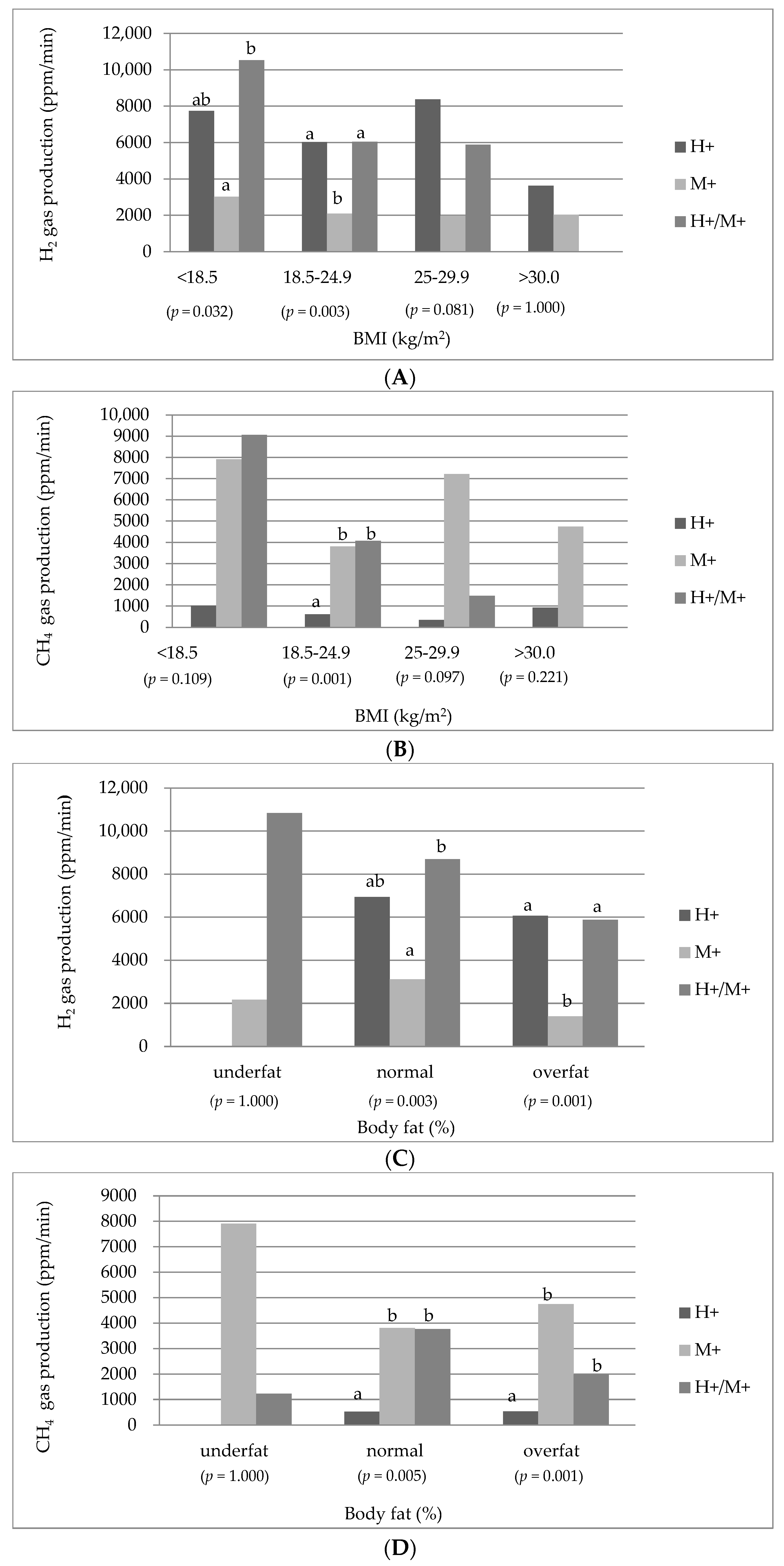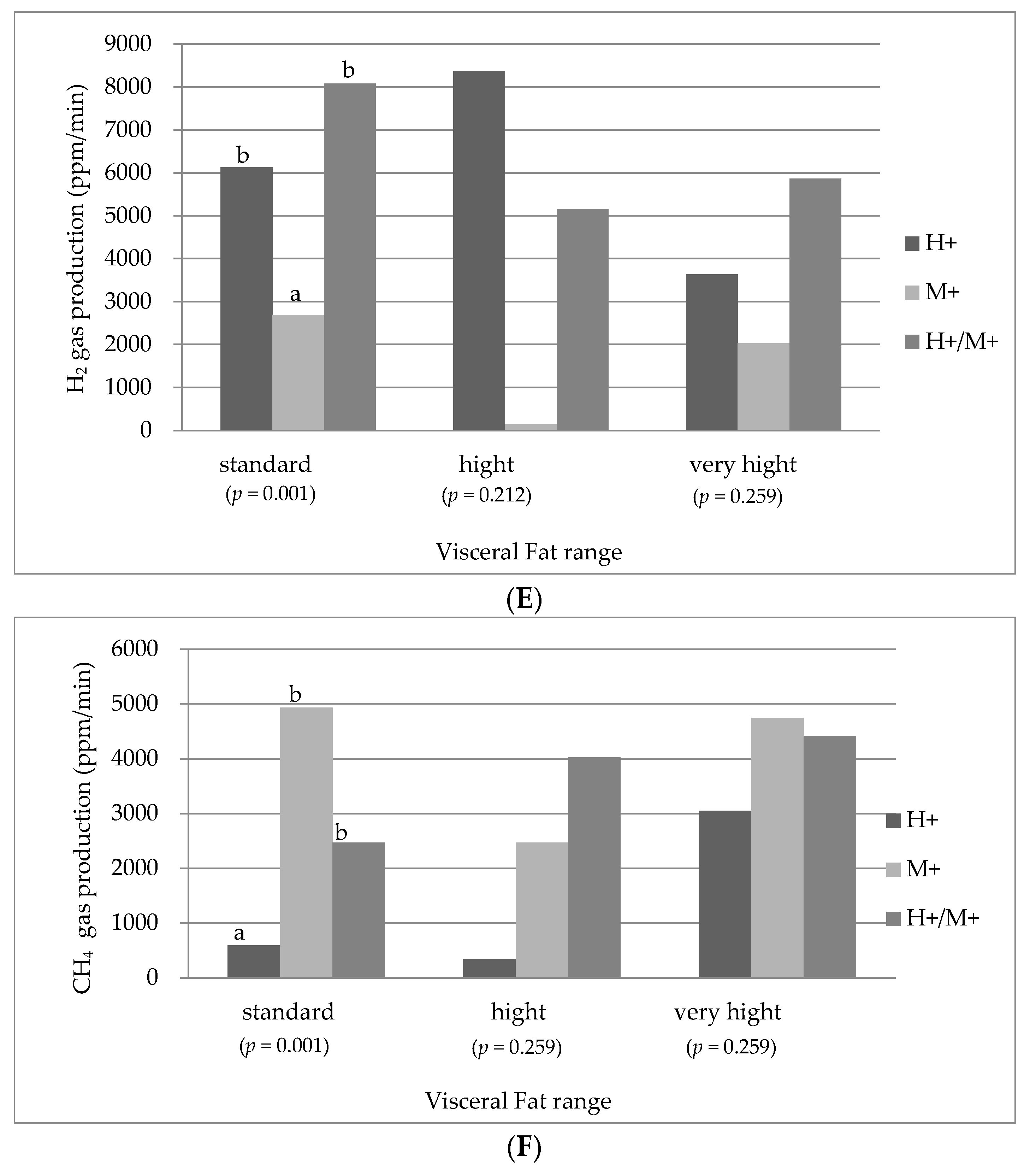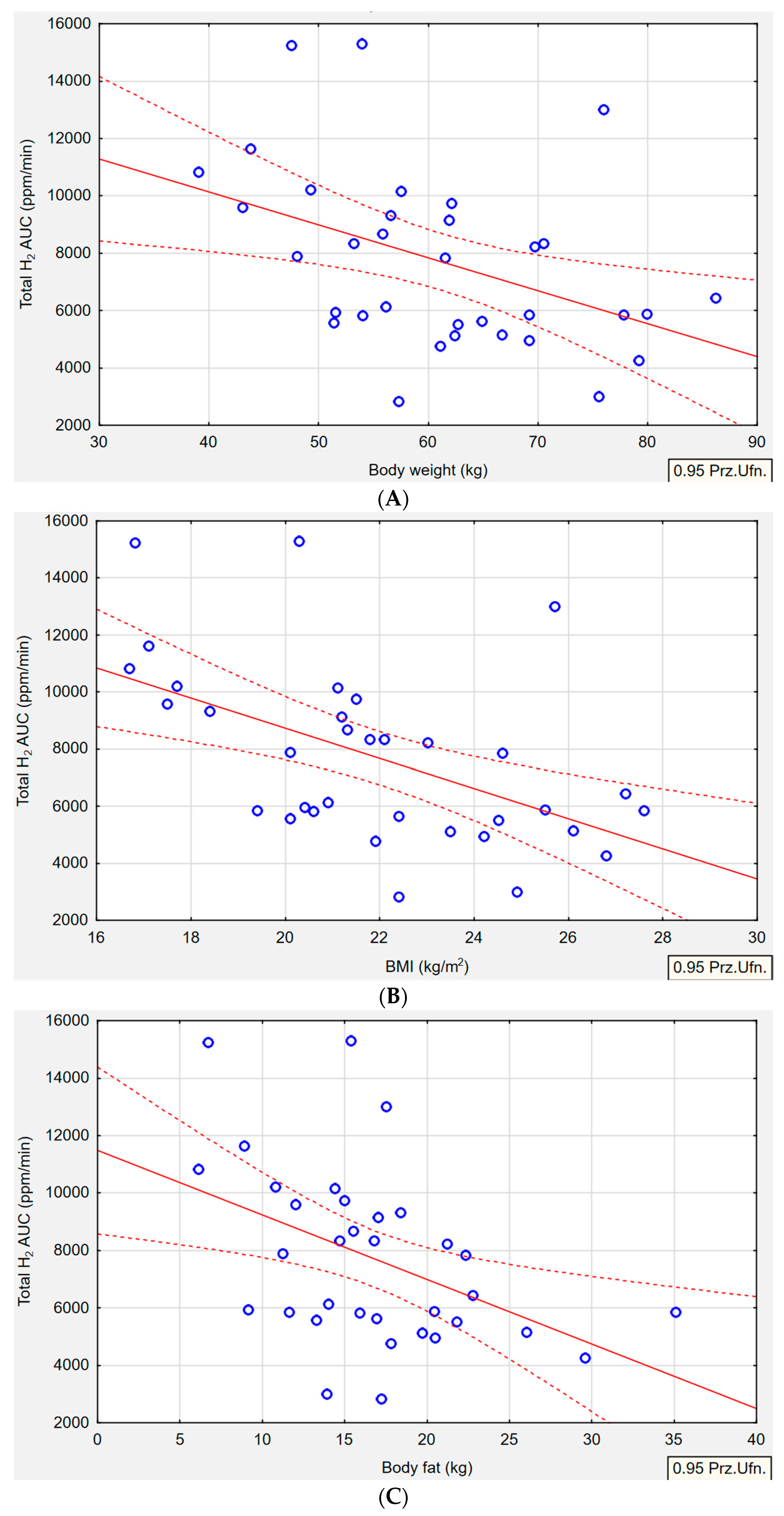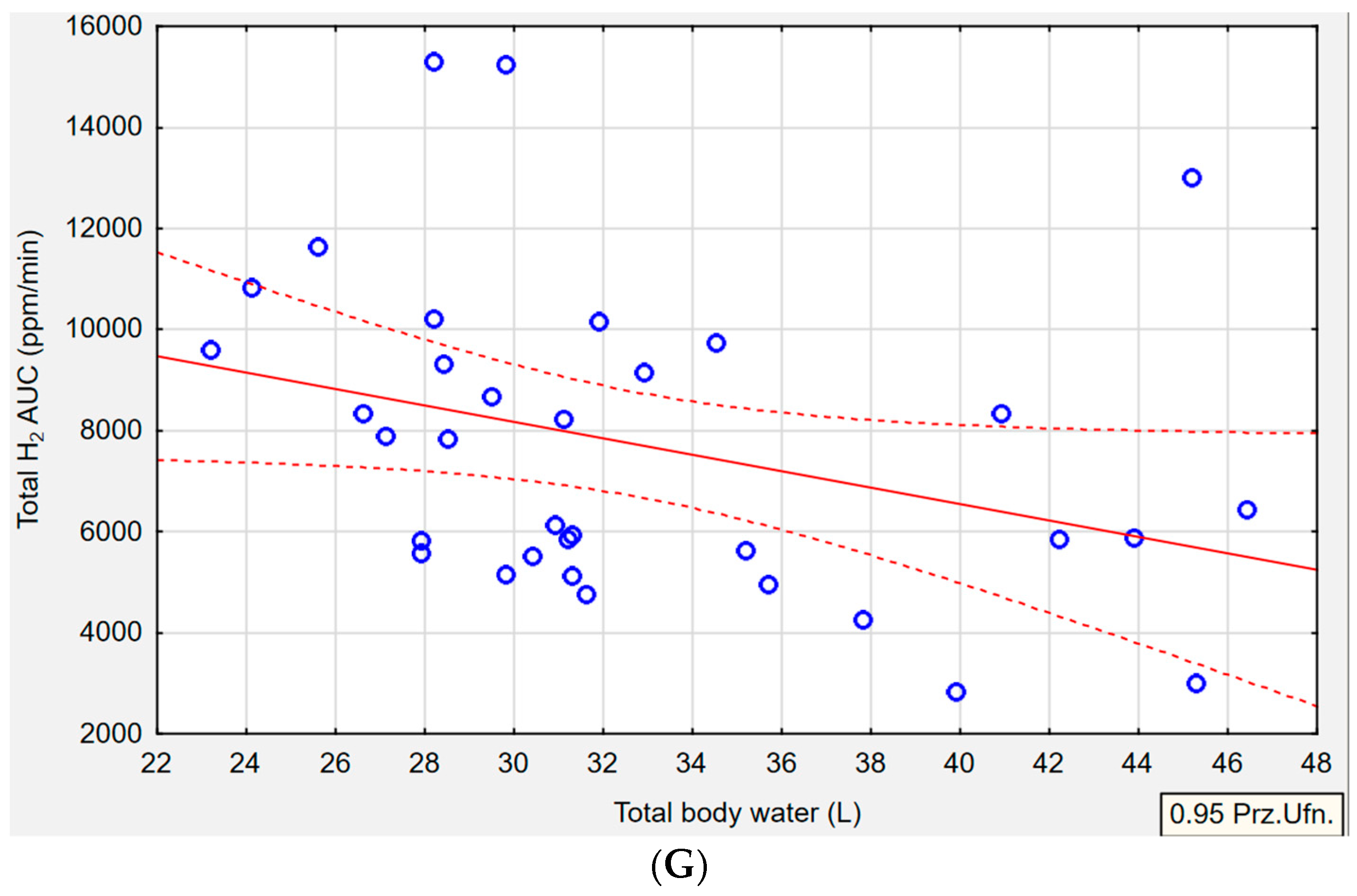Influence of Body Composition and Specific Anthropometric Parameters on SIBO Type
Abstract
:1. Introduction
2. Materials and Methods
2.1. Anthropometric Data
2.2. Questionnaire
2.3. Lactulose Hydrogen–Methane Breath Test
2.4. Outcome Measures
2.5. Statistical Analysis
3. Results
3.1. Demographics
3.2. Hydrogen and Methane Production
3.3. Body Composition
3.4. Inverse Correlations
4. Discussion
5. Conclusions
Author Contributions
Funding
Institutional Review Board Statement
Informed Consent Statement
Data Availability Statement
Acknowledgments
Conflicts of Interest
References
- Ginnebaugh, B.; Chey, W.D.; Saad, R. Small Intestinal Bacterial Overgrowth: How to Diagnose and Treat (and Then Treat Again). Gastroenterol. Clin. N. Am. 2020, 49, 571–587. [Google Scholar] [CrossRef]
- Takakura, W.; Pimentel, M. Small Intestinal Bacterial Overgrowth and Irritable Bowel Syndrome—An Update. Front. Psychiatry 2020, 11, 664. [Google Scholar] [CrossRef]
- Skrzydło-Radomańska, B.; Cukrowska, B. How to Recognize and Treat Small Intestinal Bacterial Overgrowth? J. Clin. Med. 2022, 11, 6017. [Google Scholar] [CrossRef] [PubMed]
- Rizos, E.; Pyleris, E.; Pimentel, M.; Triantafyllou, K.; Giamarellos-Bourboulis, E.J. Small Intestine Bacterial Overgrowth Can Form an Indigenous Proinflammatory Environment in the Duodenum: A Prospective Study. Microorganisms 2022, 10, 960. [Google Scholar] [CrossRef]
- Yao, Q.; Yu, Z.; Meng, Q.; Chen, J.; Liu, Y.; Song, W.; Ren, X.; Zhou, J.; Chen, X. The Role of Small Intestinal Bacterial Overgrowth in Obesity and Its Related Diseases. Biochem. Pharmacol. 2023, 212, 115546. [Google Scholar] [CrossRef]
- Bohm, M.; Siwiec, R.M.; Wo, J.M. Diagnosis and Management of Small Intestinal Bacterial Overgrowth. Nutr. Clin. Pract. 2013, 28, 289–299. [Google Scholar] [CrossRef]
- Pimentel, M.; Saad, R.J.; Long, M.D.; Rao, S.S.C. ACG Clinical Guideline: Small Intestinal Bacterial Overgrowth. Am. J. Gastroenterol. 2020, 115, 165–178. [Google Scholar] [CrossRef] [PubMed]
- Smith, N.W.; Shorten, P.R.; Altermann, E.H.; Roy, N.C.; McNabb, W.C. Hydrogen Cross-Feeders of the Human Gastrointestinal Tract. Gut Microbes 2019, 10, 270–288. [Google Scholar] [CrossRef]
- Tansel, A.; Levinthal, D.J. Understanding Our Tests: Hydrogen-Methane Breath Testing to Diagnose Small Intestinal Bacterial Overgrowth. Clin. Transl. Gastroenterol. 2023, 14, e00567. [Google Scholar] [CrossRef]
- Kumar, S.; Misra, A.; Ghoshal, U.C. Patients with Irritable Bowel Syndrome Exhale More Hydrogen than Healthy Subjects in Fasting State. J. Neurogastroenterol. Motil. 2010, 16, 299–305. [Google Scholar] [CrossRef]
- Ghoshal, U.; Shukla, R.; Srivastava, D.; Ghoshal, U.C. Irritable Bowel Syndrome, Particularly the Constipation-Predominant Form, Involves an Increase in MethanobrevibacterSmithii, Which Is Associated with Higher Methane Production. Gut Liver 2016, 10, 932–938. [Google Scholar] [CrossRef]
- Bin Waqar, S.H.; Rehan, A. Methane and Constipation-Predominant Irritable Bowel Syndrome: Entwining Pillars of Emerging Neurogastroenterology. Cureus 2019, 11, e4764. [Google Scholar] [CrossRef] [PubMed]
- Villanueva-Millan, M.J.; Leite, G.; Wang, J.; Morales, W.; Parodi, G.; Pimentel, M.L.; Barlow, G.M.; Mathur, R.; Rezaie, A.; Sanchez, M.; et al. Methanogens and Hydrogen Sulfide Producing Bacteria Guide Distinct Gut Microbe Profiles and Irritable Bowel Syndrome Subtypes. Am. J. Gastroenterol. 2022, 117, 2055–2066. [Google Scholar] [CrossRef]
- Kunkel, D.; Basseri, R.J.; Makhani, M.D.; Chong, K.; Chang, C.; Pimentel, M. Methane on Breath Testing Is Associated with Constipation: A Systematic Review and Meta-Analysis. Dig. Dis. Sci. 2011, 56, 1612–1618. [Google Scholar] [CrossRef]
- Krajicek, E.J.; Hansel, S.L. Small Intestinal Bacterial Overgrowth: A Primary Care Review. Mayo Clin. Proc. 2016, 91, 1828–1833. [Google Scholar] [CrossRef]
- Rao, S.S.C.; Bhagatwala, J. Small Intestinal Bacterial Overgrowth: Clinical Features and Therapeutic Management. Clin. Transl. Gastroenterol. 2019, 10, e00078. [Google Scholar] [CrossRef]
- Rezaie, A.; Buresi, M.; Lembo, A.; Lin, H.; McCallum, R.; Rao, S.; Schmulson, M.; Valdovinos, M.; Zakko, S.; Pimentel, M. Hydrogen and Methane-Based Breath Testing in Gastrointestinal Disorders: The North American Consensus. Am. J. Gastroenterol. 2017, 112, 775–784. [Google Scholar] [CrossRef]
- Tziatzios, G.; Giamarellos-Bourboulis, E.J.; Papanikolaou, I.S.; Pimentel, M.; Dimitriadis, G.D.; Triantafyllou, K. Is Small Intestinal Bacterial Overgrowth Involved in the Pathogenesis of Functional Dyspepsia? Med. Hypotheses 2017, 106, 26–32. [Google Scholar] [CrossRef]
- Burke, M. Carbohydrate Intolerance and Disaccharidase Measurement—A Mini-Review. Clin. Biochem. Rev. 2019, 40, 167–174. [Google Scholar] [CrossRef]
- Ghoshal, U.C.; Shukla, R.; Ghoshal, U. Small Intestinal Bacterial Overgrowth and Irritable Bowel Syndrome: A Bridge between Functional Organic Dichotomy. Gut Liver 2017, 11, 196–208. [Google Scholar] [CrossRef]
- Shah, A.; Morrison, M.; Burger, D.; Martin, N.; Rich, J.; Jones, M.; Koloski, N.; Walker, M.M.; Talley, N.J.; Holtmann, G.J. Systematic Review with Meta-Analysis: The Prevalence of Small Intestinal Bacterial Overgrowth in Inflammatory Bowel Disease. Aliment. Pharmacol. Ther. 2019, 49, 624–635. [Google Scholar] [CrossRef]
- Losurdo, G.; D’abramo, F.S.; Indellicati, G.; Lillo, C.; Ierardi, E.; Di Leo, A. The Influence of Small Intestinal Bacterial Overgrowth in Digestive and Extra-Intestinal Disorders. Int. J. Mol. Sci. 2020, 21, 3531. [Google Scholar] [CrossRef]
- Avelar Rodriguez, D.; Ryan, P.M.D.; Toro Monjaraz, E.M.; Ramirez Mayans, J.A.; Quigley, E.M. Small Intestinal Bacterial Overgrowth in Children: A State-of-the-Art Review. Front. Pediatr. 2019, 7, 363. [Google Scholar] [CrossRef]
- Bures, J.; Cyrany, J.; Kohoutova, D.; Förstl, M.; Rejchrt, S.; Kvetina, J.; Vorisek, V.; Kopacova, M. Small Intestinal Bacterial Overgrowth Syndrome. World J. Gastroenterol. 2010, 16, 2978–2990. [Google Scholar] [CrossRef]
- de Sire, A.; de Sire, R.; Curci, C.; Castiglione, F.; Wahli, W. Role of Dietary Supplements and Probiotics in Modulating Microbiota and Bone Health: The Gut-Bone Axis. Cells 2022, 11, 743. [Google Scholar] [CrossRef]
- Santos, A.N.d.R.; Soares, A.C.F.; Oliveira, R.P.; de Morais, M.B. The Impact of Small Intestinal Bacterial Overgrowth on the Growth of Children and Adolescents. Rev. Paul. Pediatr. 2020, 38, e2018164. [Google Scholar] [CrossRef]
- Wijarnpreecha, K.; Werlang, M.E.; Watthanasuntorn, K.; Panjawatanan, P.; Cheungpasitporn, W.; Gomez, V.; Lukens, F.J.; Ungprasert, P. Obesity and Risk of Small Intestine Bacterial Overgrowth: A Systematic Review and Meta-Analysis. Dig. Dis. Sci. 2020, 65, 1414–1422. [Google Scholar] [CrossRef]
- Roland, B.C.; Lee, D.; Miller, L.S.; Vegesna, A.; Yolken, R.; Severance, E.; Prandovszky, E.; Zheng, X.E.; Mullin, G.E. Obesity Increases the Risk of Small Intestinal Bacterial Overgrowth (SIBO). Neurogastroenterol. Motil. 2018, 30, e131999. [Google Scholar] [CrossRef]
- Ferolla, S.M.; Armiliato, G.N.A.; Couto, C.A.; Ferrari, T.C.A. The Role of Intestinal Bacteria Overgrowth in Obesity-Related Nonalcoholic Fatty Liver Disease. Nutrients 2014, 6, 5583–5599. [Google Scholar] [CrossRef]
- Leech, B.; McIntyre, E.; Steel, A.; Sibbritt, D. Risk Factors Associated with Intestinal Permeability in an Adult Population: A Systematic Review. Int. J. Clin. Pract. 2019, 73, e13385. [Google Scholar] [CrossRef]
- Lee, S.H.; Cho, D.Y.; Joo, N.S.; Kim, K.N. Effect of Eradicating Hydrogen-Forming Small Intestinal Bacterial Overgrowth with Rifaximin on Body Weight Change. Medicine 2019, 98, e18396. [Google Scholar] [CrossRef]
- Fialho, A.; Fialho, A.; Thota, P.; McCullough, A.; Shen, B. Higher Visceral to Subcutaneous Fat Ratio Is Associated with Small Intestinal Bacterial Overgrowth. Nutr. Metab. Cardiovasc. Dis. 2016, 26, 773–777. [Google Scholar] [CrossRef]
- Mathur, R.; Amichai, M.; Chua, K.S.; Mirocha, J.; Barlow, G.M.; Pimentel, M. Methane and Hydrogen Positivity on Breath Test Is Associated with Greater Body Mass Index and Body Fat. J. Clin. Endocrinol. Metab. 2013, 98, 698–702. [Google Scholar] [CrossRef]
- Basseri, R.J.; Basseri, B.; Pimentel, M.; Chong, K.; Youdim, A.; Low, K.; Hwang, L.; Soffer, E.; Chang, C.; Mathur, R. Intestinal Methane Production in Obese Individuals Is Associated with a Higher Body Mass Index. Gastroenterol. Hepatol. 2012, 8, 22–28. [Google Scholar]
- Cortez, A.P.B.; Fisberg, M.; de Morais, M.B. Intestinal Permeability and Small Intestine Bacterial Overgrowth in Excess Weight Adolescents. Pediatr. Obes. 2021, 16, e12741. [Google Scholar] [CrossRef]
- Jung, S.E.; Joo, N.S.; Han, K.S.; Kim, K.N. Obesity Is Inversely Related to Hydrogen-Producing Small Intestinal Bacterial Overgrowth in Non-Constipation Irritable Bowel Syndrome. J. Korean Med. Sci. 2017, 32, 948–953. [Google Scholar] [CrossRef]
- Stotzer, P.O.; Johansson, C.; Mellström, D.; Lindstedt, G.; Kilander, A.F. Bone Mineral Density in Patients with Small Intestinal Bacterial Overgrowth. Hepatogastroenterology 2003, 50, 1415–1418. [Google Scholar]
- Koutoukidis, D.A.; Jebb, S.A.; Zimmerman, M.; Otunla, A.; Henry, J.A.; Ferrey, A.; Schofield, E.; Kinton, J.; Aveyard, P.; Marchesi, J.R. The Association of Weight Loss with Changes in the Gut Microbiota Diversity, Composition, and Intestinal Permeability: A Systematic Review and Meta-Analysis. Gut Microbes 2022, 14, 2020068. [Google Scholar] [CrossRef]
- Rasmussen, J.; Duriancik, D.M. Management of Small Intestinal Bacterial Overgrowth in Adult Patients. Gastroenterol. Nurs. 2019, 42, 269–276. [Google Scholar] [CrossRef]
- Miazga, A.; Osiński, M.; Cichy, W.; Zaba, R. Current Views on the Etiopathogenesis, Clinical Manifestation, Diagnostics, Treatment and Correlation with Other Nosological Entities of SIBO. Adv. Med. Sci. 2015, 60, 118–124. [Google Scholar] [CrossRef] [PubMed]
- Nucera, G.; Gabrielli, M.; Lupascu, A.; Lauritano, E.C.; Santoliquido, A.; Cremonini, F.; Cammarota, G.; Tondi, P.; Pola, P.; Gasbarrini, G.; et al. Abnormal Breath Tests to Lactose, Fructose and Sorbitol in Irritable Bowel Syndrome May Be Explained by Small Intestinal Bacterial Overgrowth. Aliment. Pharmacol. Ther. 2005, 21, 1391–1395. [Google Scholar] [CrossRef]
- Fan, X.; Sellin, J.H. Review Article: Small Intestinal Bacterial Overgrowth, Bile Acid Malabsorption and Gluten Intolerance as Possible Causes of Chronic Watery Diarrhoea. Aliment. Pharmacol. Ther. 2009, 29, 1069–1077. [Google Scholar] [CrossRef]
- Singh, R.; Zogg, H.; Wei, L.; Bartlett, A.; Ghoshal, U.C.; Rajender, S.; Ro, S. Gut Microbial Dysbiosis in the Pathogenesis of Gastrointestinal Dysmotility and Metabolic Disorders. J. Neurogastroenterol. Motil. 2021, 27, 19–34. [Google Scholar] [CrossRef]





| Gas Production | H+ | M+ | H+/M+ |
|---|---|---|---|
| H2 | >20 ppm from the baseline within 90 min | <20 ppm from the baseline within 90 min | >20 ppm from the baseline within 90 min |
| CH4 | <10 ppm | >10 ppm | >10 ppm |
| H+ (n = 12) | M+ (n = 21) | H+/M+ (n = 34) | p-Value * | |
|---|---|---|---|---|
| Age (years) | 35.25 + 11.67 | 33.29 ± 6.56 | 32.71 ± 8.23 | 0.776 |
| Gender | 0.921 | |||
| Female | 9 (75.0%) | 17 (80.9) | 27 (79.4%) | |
| Male | 3 (25.0%) | 4 (19.1%) | 7 (20.5%) | |
| Gastrointestinal symptoms | ||||
| Abdominal pain | 8 (66.6) | 17 (80.9%) | 20 (58.8%) | 0.242 |
| Diarrhea | 9 (75.0%) a | 4 (19.0%) b | 15 (44.1%) ab | 0.007 * |
| Constipation | 3 (25%) a | 15 (72.4%) b | 18 (52.9%) ab | 0.038 * |
| Reflux | 4 (33.3%) | 6 (28.5%) | 10 (29.4%) | 0.957 |
| Gas | 8 (66.6%) | 16 (76.1%) | 31 (91%) | 0.118 |
| Growling | 7 (58.3%) | 12 (57.1%) | 28 (82.3%) | 0.089 |
| Bloating | 10 (83.3%) | 20 (95.2%) | 32 (94.1%) | 0.408 |
| Frequency of symptoms | ||||
| Once a week | 2 (16.6%) | 2 (9.5%) | 5 (14.7%) | 0.934 |
| Few times per week | 3 (25.0%) | 7 (33.3%) | 11 (32.3%) | |
| Once a day | 2 (16.6%) | 2 (9.5%) | 5 (14.7%) | |
| Few times per day | 5 (41.6%) | 10 (47.6%) | 13 (38.23%) | |
| H+ (n = 12) | M+ (n = 21) | H+/M+ (n = 34) | p-Value * | |
|---|---|---|---|---|
| Median (min-max) | Median (min-max) | Median (min-max) | ||
| Hydrogen | ||||
| 0–90 min AUC (ppm/min) | 1260.0 (580.0; 2335.0) a | 310.0 (0.0; 2400.0) b | 1172.5 (405.0; 4455.0) a | 0.001 |
| 90–180 min AUC (ppm/min) | 4705.0 (2660; 8225.0) a | 2045.0 (40.0; 10,425.0) b | 5322.5 (1960.0; 11,315.0) a | 0.001 |
| Total AUC (ppm/min) | 6160.0 (3630.0; 10,560.0) a | 2360.0 (140.0; 12,825.0) b | 7155.0 (2848.0; 15,310.0) a | 0.001 |
| Methane | ||||
| Basal (ppm) | 0.0 (0.0; 3.0) a | 15.0 (3.0; 54.0) b | 6.5 (0.0; 27.00) c | 0.001 |
| Total AUC (ppm/min) | 532.5 (10.0; 930.0) a | 4510.0 (1340.0; 13,090.0) b | 2267.5 (1060; 9850.0) b | 0.001 |
| H+ (n = 12) | M+ (n = 21) | H+/M+ (n = 34) | p-Value * | |
|---|---|---|---|---|
| Median (min-max) | Median (min-max) | Median (min-max) | ||
| Height (cm) | 172.5 (158.0–192.0) a | 170.0 (159.0–185.0) ab | 166.0 (153.0–189.0) b | 0.023 * |
| Weight (kg) | 65.7 (45.0–109.8) | 62.2 (45.8–92.3) | 61.3 (39.0–86.2) | 0.236 + |
| Body fat (%) | 29.9 (17.3–36.0) | 24.4 (11.4–46.4) | 26.9 (14.1–45.1) | 0.924 + |
| Body fat (kg) | 19.4 (10.9–37.3) | 13.7 (6.5–42.6) | 16.35 (6.1–35.1) | 0.147 + |
| Lean Body mass (kg) | 47.5 (34.1–81.1) | 48.4 (37.8–64.6) | 42.25 (31.7–63.4) | 0.104 + |
| Skeletal muscle mass (kg) | 26.0 (18.1–46.0) a | 26.8 (20.4–36.8) a | 23.1 (16.6–36.0)b | 0.044 + |
| Total Water (L) | 31.2 (23.9–59.4) | 35.0 (26.5–47.1) | 31.1 (23.2–46.4) | 0.396 * |
| Body protein (kg) | 8.3 (6.4–15.9) | 9.5 (7.4–13.9) | 8.4 (6.2–12.6) | 0.206 + |
| Mineral (kg) | 3.3 (2.4–5.8) | 3.4 (2.7–4.6) | 2.9 (2.3–4.4) | 0.392 + |
| Visceral fat (cm2) | 80 (40.0–170.0) | 50.0 (20.0–190.0) | 65.0 (20.0–180.0) | 0.170 + |
| BMI (kg/m2) | 21.8 (18.0–32.3) | 21.0 (17.2–32.6) | 21.7 (16.7–27.6) | 0.711 + |
| WHR | 0.87 (0.74–1.1) | 0.86 (0.74–0.99) | 0.85 (0.76–1.0) | 0.715 * |
| Classification | ||||||||||
|---|---|---|---|---|---|---|---|---|---|---|
| BMI | Body Fat | Visceral Fat Area | ||||||||
| underweight | healthy | overweight | obese | underfat | normal | overfat | standard | high | very high | |
| H+ | 8% | 67% | 17% | 8% | 9% | 38% | 53% | 88% | 9% | 3% |
| M+ | 13% | 67% | 10% | 10% | 14% | 57% | 28% | 86% | 5% | 9% |
| H+/M+ | 18% | 64% | 18% | 0% | 0% | 34% | 66% | 75% | 17% | 8% |
| p-Value * | p = 0.991 | p = 0.597 | p = 0.548 | |||||||
Disclaimer/Publisher’s Note: The statements, opinions and data contained in all publications are solely those of the individual author(s) and contributor(s) and not of MDPI and/or the editor(s). MDPI and/or the editor(s) disclaim responsibility for any injury to people or property resulting from any ideas, methods, instructions or products referred to in the content. |
© 2023 by the authors. Licensee MDPI, Basel, Switzerland. This article is an open access article distributed under the terms and conditions of the Creative Commons Attribution (CC BY) license (https://creativecommons.org/licenses/by/4.0/).
Share and Cite
Wielgosz-Grochowska, J.P.; Domanski, N.; Drywień, M.E. Influence of Body Composition and Specific Anthropometric Parameters on SIBO Type. Nutrients 2023, 15, 4035. https://doi.org/10.3390/nu15184035
Wielgosz-Grochowska JP, Domanski N, Drywień ME. Influence of Body Composition and Specific Anthropometric Parameters on SIBO Type. Nutrients. 2023; 15(18):4035. https://doi.org/10.3390/nu15184035
Chicago/Turabian StyleWielgosz-Grochowska, Justyna Paulina, Nicole Domanski, and Małgorzata Ewa Drywień. 2023. "Influence of Body Composition and Specific Anthropometric Parameters on SIBO Type" Nutrients 15, no. 18: 4035. https://doi.org/10.3390/nu15184035
APA StyleWielgosz-Grochowska, J. P., Domanski, N., & Drywień, M. E. (2023). Influence of Body Composition and Specific Anthropometric Parameters on SIBO Type. Nutrients, 15(18), 4035. https://doi.org/10.3390/nu15184035







